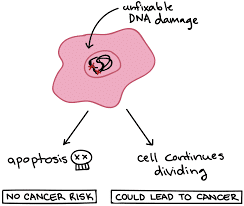
Apoptosis – Destruction of “Bad Cells”
Apoptosis is an off switch found in every human cell. This allows the body to remove problem cells or cells no longer needed in the body.
This “programmed cell death” is a rapid healthy process that removes individual cells without harming nearby cells. Before a cell will divide into two new cells it arrives at a checkpoint in the cell cycle where a test is run to see if the DNA is healthy enough to be copied. The cells use the p53 gene to run a check on the DNA, and if it finds over 50,000 to 60,000 nicks, breaks, errors, deletions or mutations, it knows this much damage cannot be repaired and will throw the off-switch to kill the cell. This prevents “bad cells” from multiplying and becoming cancer. A cell that has been designated for destruction turns inside-out and is recycled. No inflammation or immunological reactions are created by this process.
The p53 tumor suppressor protein interacts within the mitochondria (organelles responsible for energy production within each cell) to start the cascade of death signals. One way in which this normal apoptotic function can be derailed is by, hypoxia (reduced level of tissue oxygenation). It has also been found that stress markedly decreases the “bad cells” ability to self-destruct. This suppression of apoptosis allows the cancer cell to become immortal.
Anti-apoptotic signaling can also result from activity of the Bcl-2, GCl-xl, rhoA and Ras genes. Curcumin sharply shifts Bcl-2 proteins to promoting apoptosis. There are many other apoptosis promoters found in nature that have been shown to be very effective in treating cancer. One such herb is mistletoe (viscum) lectins.
When formulating a therapeutic program in treating cancer it is important to take this information along with other natural strategies to aid the body’s natural ability to kill cancer.
Terry Pfau DO, HMD
